
First, I'll tell you about the general market for the background. When everything went down, we realized that we would soon find ourselves there. And they turned out. Below is a graph where the 6th week of the year is taken as 0% (3.02.2020). Ends on the 16th week (04/05/2020).
Dynamics of demand in the labor market in the first months of self-isolation
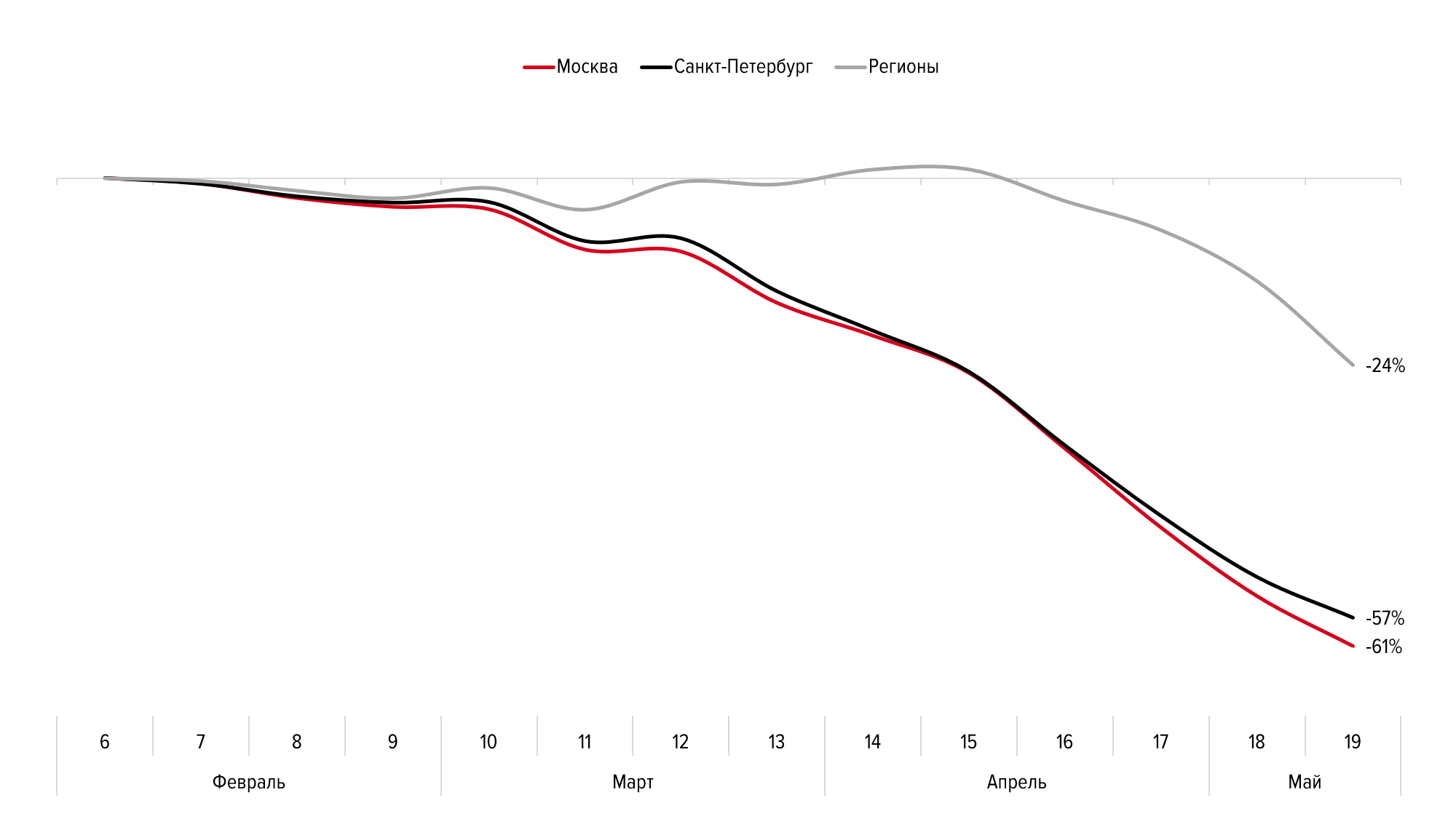
The number of published vacancies in Moscow fell by more than half by mid-May. For example, at the beginning of February ~ 125K vacancies were published in a week, in the 19th week of May only 50K were published. The graph clearly shows how the labor market reacts to the May holidays along with self-isolation.
Now about IT. Here I counted the TOP-10 requests from job seekers to search for vacancies. Only those applicants who have a resume in the professional field "Information technology, Internet, telecom". In this professional area, resumes are posted not only by developers, but also by projects, analysts, content managers, smm-specialists (up to three professional areas can be indicated in the CV). What else is important to know about the chart:
- the share of each request is calculated from the total number of requests from IT professionals per month;
- syntax queries were not combined. For example, "manager" and "project manager" are different queries here. The first hit the top 10 in April 2019, the second in the 20th place
- counted not the actual number of requests, but the number of unique logged in users who made these requests.
April 2019 - we had a great time, only Gates spoke about viruses , and I was planning trips around the world for a year in advance. The IT guys were looking for jobs with Java, Python, something for a programmer. From April to June 2019, changes in the top are within the margin of error. But in April 2020 - bam! - the courier comes first. And along with it, remote work, work from home and work with daily pay pushed even php out of the top. By June 2020, things were back to normal pretty quickly.
Popular searches from IT professionals

For a better understanding of the overall picture, I will say that the number of search queries in April 2020 fell by 44% YoY (year-over-year), and July 2020 grew by 18% by the same month of the previous year. V-shaped rebound, you say? And you will be right! The overall market is lower in 2019 compared to the current year. 6th week again for 0%.
Demand on the common market, all of Russia
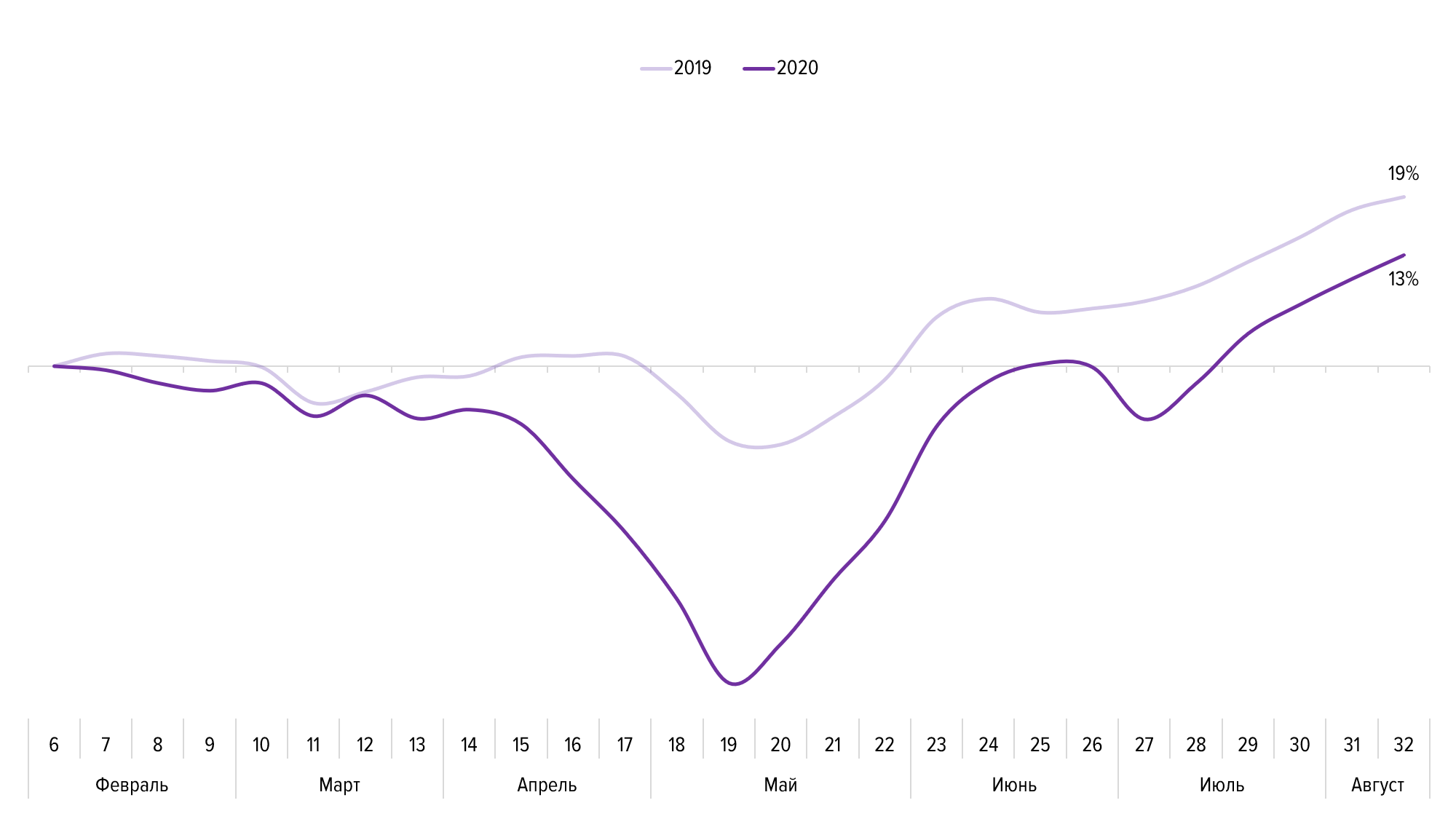
So that you are not too scared by the drop in the first chart, I give a comparison over the years - on it we see that in May the demand drops slightly for natural reasons (holidays, vacations). So, everything seems to be ok, and the regions with St. Petersburg have already reached the level for 2019, but Moscow is still lagging behind. I think it will be a matter of time if everything goes as it is.
IT demand, all of Russia

The following graph shows the number of vacancies by programming language.
List of languages under the spoiler
1C
Assembler
Bash
C
C#
C++
Delphi
Erlang /Elixir
Golang
Groovy
Java
JavaScript
Kotlin
Lua
Matlab
Objective-C
OpenGL
Pascal
Perl
PHP
PL/SQL
Python
R
Ruby
Rust
Scala
SQL
Swift
TypeScript
Visual Basic
Visual Basic.NET
Angular
Ember
JQuery
React
Vue
Assembler
Bash
C
C#
C++
Delphi
Erlang /Elixir
Golang
Groovy
Java
JavaScript
Kotlin
Lua
Matlab
Objective-C
OpenGL
Pascal
Perl
PHP
PL/SQL
Python
R
Ruby
Rust
Scala
SQL
Swift
TypeScript
Visual Basic
Visual Basic.NET
Angular
Ember
JQuery
React
Vue
I looked for references throughout the text of vacancies: in titles, descriptions, key skills. This approach does not work when there are descriptions like: “We switched from php to Java and are now looking for a Java developer”. A vacancy with such a description will be included in the statistics for both php and java. But, fortunately, there are not too many such cases to distort the overall picture. Watched through July 2019 and July 2020, throughout Russia. Top 20 languages by the number of vacancies.
Number of vacancies by programming language
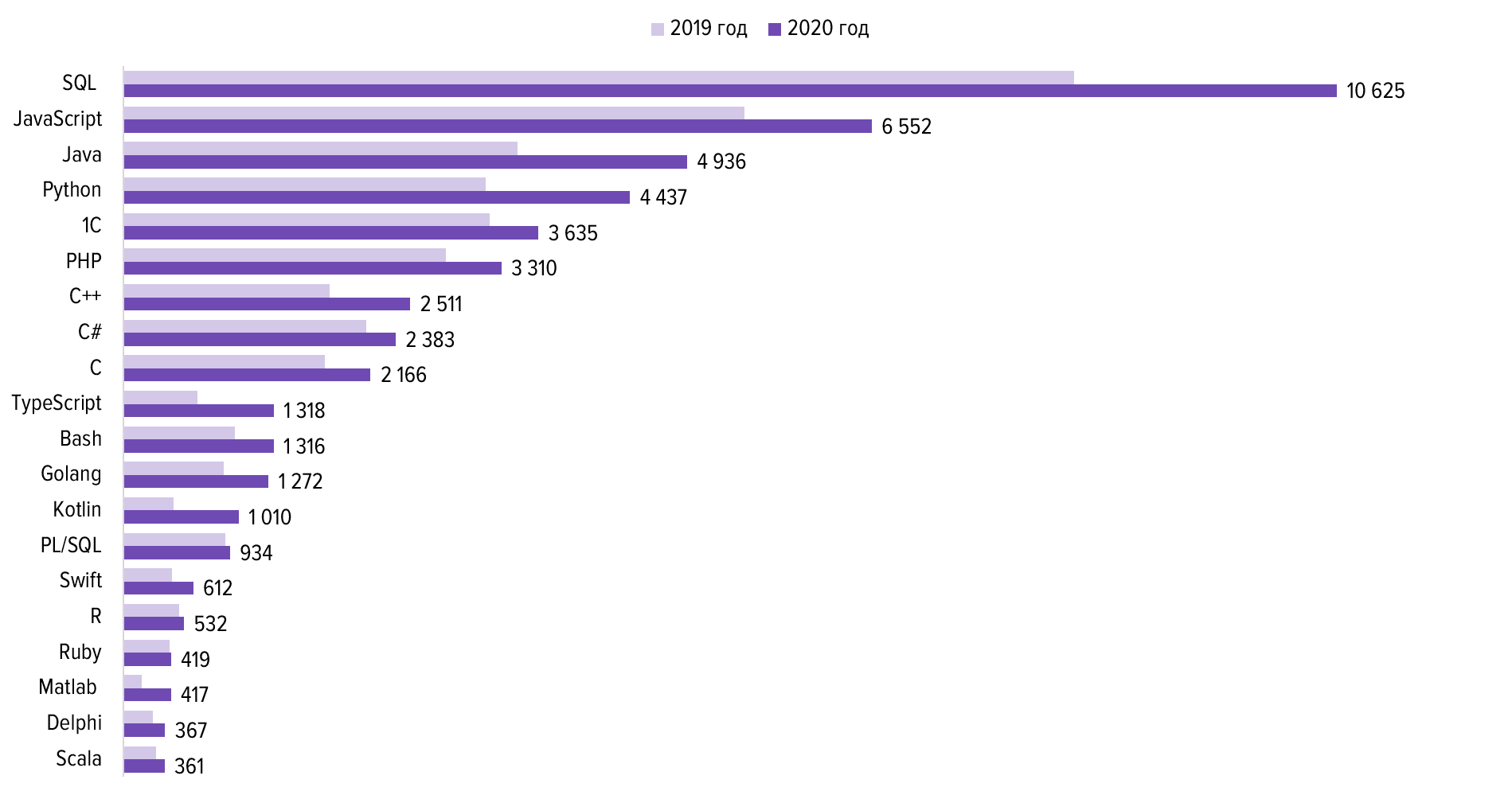
Despite the fact that July is not the most representative month for the labor market and the number of vacancies in the fall is usually higher, here we are looking at it in order to assess how alive the market is now. And he's alive. Probably, such a difference in the number of vacancies is associated with deferred demand, but, anyway, there are vacancies for developers now and there are really a lot of them.
For clarity, below is the graph for the same indicator, but we are looking at the growth. Out of the top 20 in terms of the number of vacancies, not a single language dropped.
Change in the number of vacancies in relation to the previous year

In terms of growth, everything is standard - Kotlin and Go grow every year. Matlab is growing against the background of the general demand for working with data, and everything else, apparently, has really grown due to the deferred demand and our marketing activities.
Separately for the JS frameworks - the method is the same, the number of vacancies is mentioned. July to July throughout Russia.
Number of vacancies mentioning JS frameworks
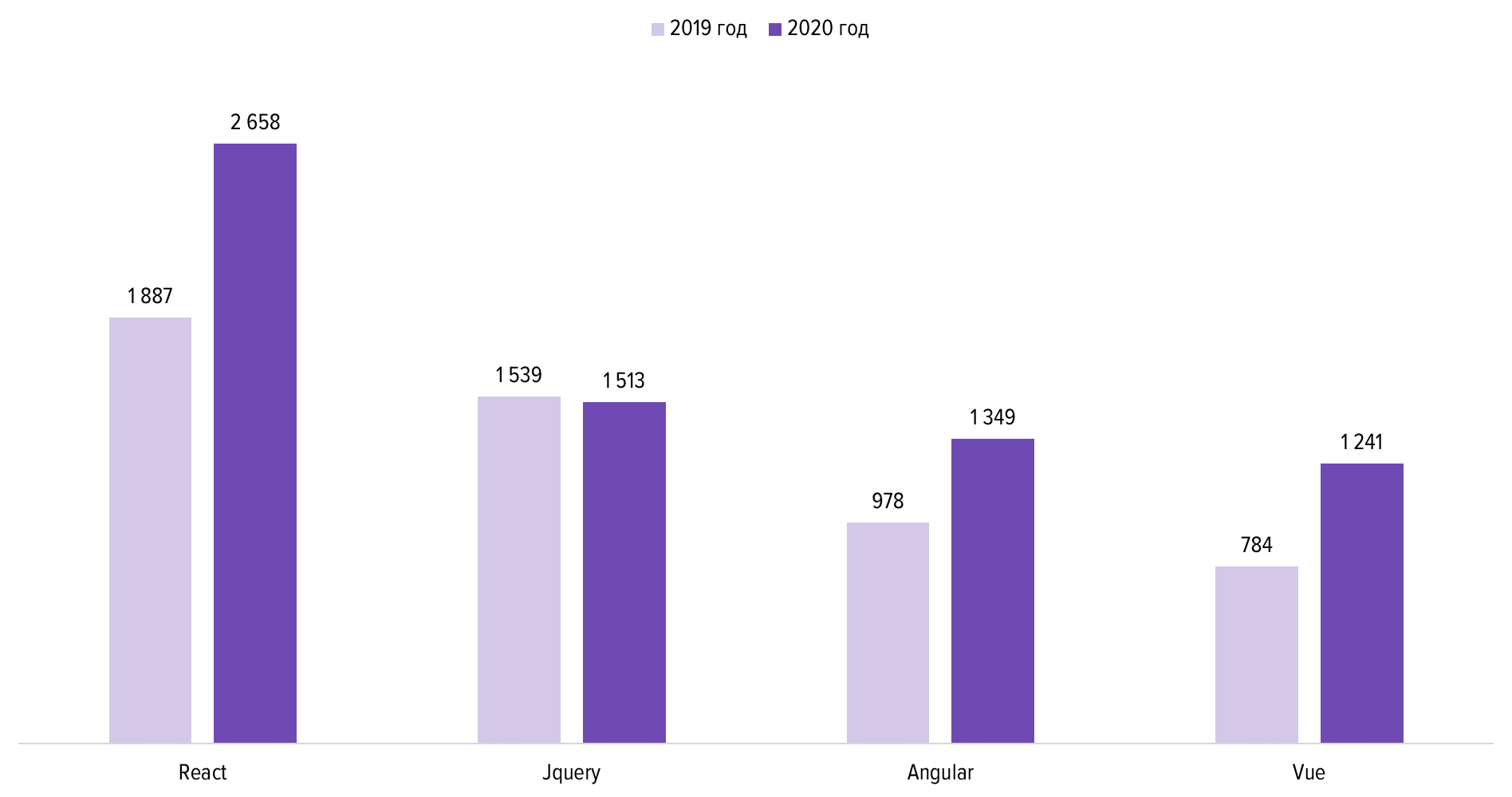
Vue and React grew by 58% and 41%, respectively. Jquery crashed within the margin of error. In summary, we can say that there are no fewer vacancies now than last summer. If you were thinking about changing jobs, then perhaps now is the best time for this, because we do not know what will happen in the fall.
Further salaries for the same vacancies. It should be borne in mind that only one knowledge of SQL will not always pay 98k, tk. the SQL sample also included vacancies with descriptions like “SQL at a good level; Python: Pandas, Numpy, Matplotlib, ... ".
Proposed salaries by programming language

An important point is statistics for the whole of Russia, but without detailing on Juniors and Seniors. If there is a feeling that your current salary is not in the market, the coolest and easiest way is to look at vacancies and resumes on hh according to your profile. An even more important point is that salaries in all languages are steadily increasing from year to year.
Further data from the summary. In the next graph, the principle is the same as in vacancies - I looked for the names of languages in all fields in the resume. The data is also for July throughout Russia.
Number of CVs by programming language (mentions in any field)

Top 20 in terms of quantity. I was looking for references to 1C only with the words "developer" or synonyms. Go did not make it into the top twenty, if you count mentions in any field of the resume, but then a graph with mentions only in titles.
Number of CVs by programming languages (mentions in title)
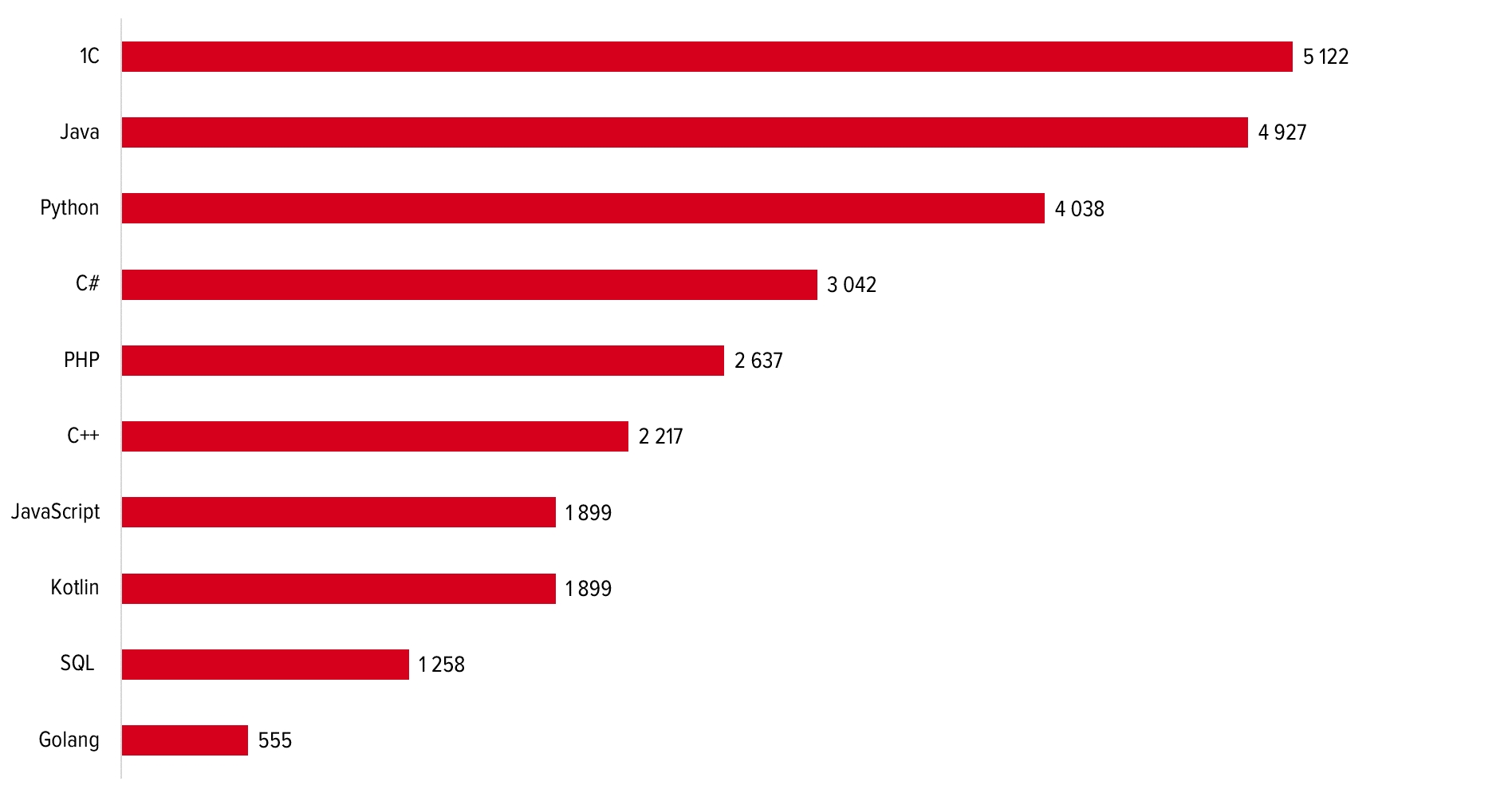
Here Golang is in the top ten.
And then the expected salaries. I add the median on the chart, because the volatile mean itself is even more volatile on resume data. I counted from CVs collected from references in any field. All around Russia.
Expected salaries by programming language

It also has the top 20. JS and php did not exceed a hundred, python did not reach the top just a little bit.
Summing up: the demand in the IT market is higher than ever - if you were planning to change jobs, now is a good time. If you were planning to find - now you have the highest chances in the last six months. That's all. If some programming language is missing from the review, write in the comments - let's look at it separately.
PS It would be great if you watch our survey for IT professionals .

In the next article I will publish the results of the survey when we collect 1000 answers from Habr)